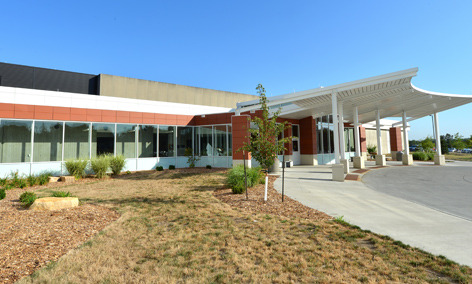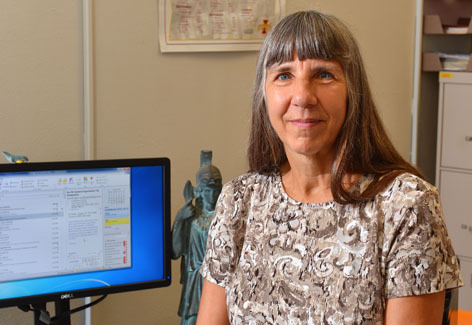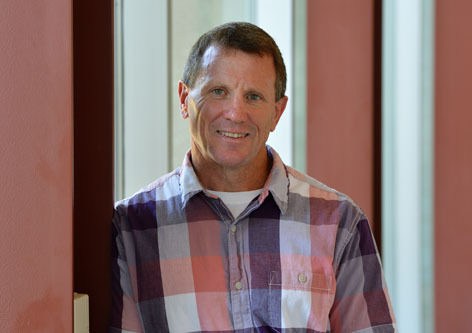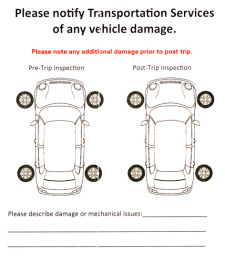Small animal hospital is golden

Reusing the former large animal hospital structure, visible above and behind the glass corridor at the new entrance, helped the small animal hospital project in the College of Veterinary Medicine earn a LEED® Gold certification. Photo by Bob Elbert.
The renovation and construction that produced a state-of-the-art small animal hospital at the College of Veterinary Medicine has earned Iowa State another LEED® Gold certification, the second highest level in the green building rating system. The university strives for gold certification or higher on new building and major renovation projects.
LEED (Leadership in Energy and Environmental Design) was introduced by the U.S. Green Building Council in 1998 to measure environmentally sensitive building design, construction, operations and maintenance. The standards in this voluntary program are becoming more stringent as it evolves.
"We are certainly proud to be awarded the LEED Gold certification," said Dr. Lisa Nolan, the Dr. Stephen G. Juelsgaard Dean of Veterinary Medicine. "It was our vision to design a hospital to better serve our clients and patients while reducing the hospital's environmental footprint. The result is one of the most advanced veterinary teaching hospitals in the world and one that both conserves environmental resources and enhances our ability to provide exceptional care to our patients and to train future veterinarians. Truly a win-win for the citizens of Iowa."
LEED measures achievements in five categories and awards a credit total. The small animal hospital project scored 41 out of 69 possible credits.
"It's always a balancing act to develop the best facilities for the academic programs while doing it in a sustainable manner using high-efficient building systems," said Steve Prater, facilities planning and management's project manager for the small animal hospital. "The program requirements of a hospital have to be the first priority."
Challenges to gold
In this case, he said the college's remote location from central campus made LEED gold certification an especially satisfying accomplishment. Iowa State wasn't able to earn credits in several site-related categories that recognize a building's connection to its neighborhood, for example, service by multiple bus routes, shared parking and other integration with an existing community.
But the project scored well in the building materials, building energy systems and indoor air quality categories, including credit for leaving intact about 75 percent of walls, floors and roof of the former large animal hospital and for recycling or reusing 96 percent of the demolition and construction waste.
Other achievements that earned the small animal hospital its gold rating include:
- Paints, carpets, adhesives and sealants used indoors emit no or low levels of toxins
- By dollar value, 22 percent of the new building materials used have recycled content
- For the first two years, 70 percent of the hospital's electricity will be provided by renewable sources (to help develop the "green" grid)
- Low-flush urinals and toilets and low-flow sink faucets and shower heads reduce water consumption by 45 percent
- Site landscaping features native and native hybrid plants and has no irrigation system
- A heat recovery system captures the heat and cool from air that is exhausted eight times an hour from laboratories (air itself can't be reused), resulting in a 15 percent reduction in energy use
- Refrigerants in the HVAC system are free of compounds that contribute to ozone depletion
- Approximately 58 percent of wood building materials is certified (grown and harvested according to sustainable forestry standards)
- About 22 percent of building products contain material extracted, harvested and manufactured within 500 miles of Ames
- The faculty office building addition has energy-efficient features such as in-floor radiant heating, chilled beam cooling and exterior awnings that block the high summer sun but let in the winter sun
Small Animal Hospital, Lloyd Veterinary Medical Center
LEED® scorecard
| Category | Credits earned | Possible |
| Sustainable site | 5 | 14 |
| Water efficiency | 4 | 5 |
| Building energy performance | 8 | 17 |
| Sustainable building materials | 8 | 13 |
| Indoor environmental quality | 12 | 15 |
| Bonus credits: Innovation in design | 4 | 5 |
| Total | 41 | 69 |
Other Iowa State construction projects to receive LEED certification include the College of Design King Pavilion (platinum), State Gym renovation and addition (platinum), Hach Hall (gold), Biorenewables Laboratory (gold) and the Morrill Hall renovation (silver). The university will seek LEED certification for Troxel Hall, the football training complex, Curtiss Hall renovations, phase 2 of the biorenewables complex and Hansen Agriculture Student Learning Center.
Access your work files from almost anywhere
If you email work files to yourself or often carry those files around on a thumb drive, consider trying CyBox, Iowa State's new cloud-based storage system.
Storage options
Here's a list of ITS' storage services for individuals, departments and research projects.
This convenient tool for stashing and retrieving work files was rolled out last spring and has attracted several thousand users. Nice features of the new system include:
- Easy setup. Faculty, staff and students have instant access to the free service. To start using CyBox, simply go to iastate.box.com and sign in with your ISU Net-ID and password.
- Access anywhere. If you can get to the Internet, you can get to your CyBox.
- Lots of space. Faculty and staff automatically get 50GB of space and students get 25GB. Individuals can obtain more free space under special circumstances.
- More data security. Unlike other storage accounts, CyBox meets standards of the Family Educational Rights and Privacy Act (FERPA).
- Sharing on campus and beyond. You can selectively share folders or files with anyone via an email address or link.
- Special apps. CyBox comes with several free applications to make it easy to transfer and work on files. Particularly useful is Box Sync for Windows or Mac, which allows you to access shared files and folders right from your computer's desktop.
CyBox is a version of the popular storage site Box.com that's been tailored for an educational institution, said Mike Lohrbach, information technology services senior systems analyst. ISU has contracted with Box.com to ensure that CyBox has beefed-up security to protect student privacy required by FERPA. Those contracts also guarantee that data in CyBox stays within the continental United States and that Iowa State retains ownership of the data.
"Because of the security aspects, we encourage faculty and staff to move work-related projects from other free cloud storage accounts to CyBox," Lohrbach said.
CyBox vs. CyFiles
Faculty, staff and students also have access to another free storage option, CyFiles, launched a couple of years ago. The table below shows key differences between the two storage systems.
|
CyBox |
CyFiles |
|
50GB storage for faculty, staff |
5GB storage for faculty, staff |
|
Stored files can be accessed anywhere via web browser or mobile app |
Off-campus access requires use of VPN (virtual private network) software |
|
Files can be shared with anyone via email address or link |
Files can be shared with Iowa State faculty, staff, students |
| Accessible via web or app | Accessible via mapped drive or mounted volume |
Meet Veronica Dark, Faculty Senate president

Faculty Senate president Veronica Dark. Photo by Bob Elbert.
Position
Professor and director of undergraduate students in the psychology department
Years at Iowa State
27
Describe your work.
My research area is selective attention; I'm a cognitive psychologist by training. I put people in front of a computer, overwhelm them with information and determine what they can pick up. I look at the variables that influence what it is that they are able to pick up when there is too much information.
What one word would you use to describe yourself?
Scuba diver.
What interests do you have outside of work?
Scuba diving and my grandkids (5-year-old twins). Once a year, I go to Bonaire -- off the coast of Venezuela and a part of the Netherlands. There is nothing to do on that island except scuba dive. It's perfect.
What strengths do you bring to the Faculty Senate presidency?
I've been here a long time, so I have a lot of background knowledge. I'm a good listener and I'm -- what I'll call -- quietly assertive.
What is your top senate priority this year?
We're going to examine the position responsibility statement (PRS). That's really an important document for each faculty member because it's the basis of annual evaluations and promotion and tenure decisions. It's my understanding that there is wide, wide variability across campus in the nature of the PRS. It's time we looked at it and maybe came up with some best practices or guidelines.
What challenges face the senate this year?
The main challenge for the senate is for everyone involved to take it seriously. Not all senators report the issues that the senate is discussing to their departments in order to get feedback. It should be a two-way communication.
There have been times in the past when central administration hasn't thought of the senate when it should. The senate represents the entire faculty. Asking a faculty member to be part of a group isn't sufficient; they should involve the senate.
We need to enhance communication, maybe by writing short executive summaries of senate meetings for department chairs and for senators to forward to their constituencies. We could do the same for senate councils and committees. Faculty need to know the issues being discussed so they have a chance to give input.
Meet Steve Mayberry, Professional and Scientific Council president

Professional and Scientific Council president Steve Mayberry. Photo by Bob Elbert.
Position
Assistant manager of environmental programs in environmental health and safety
Years at Iowa State
15
Describe your work.
I manage several water quality programs -- storm water management and nondomestic waste water are two examples. ISU has implemented best management practices on construction sites to prevent soil runoff for areas with disturbed soils, and incorporated multiple low-impact storm water treatment features, such as retention ponds, bioswales, rain gardens and green roofs. There are several grass areas on campus that have been seeded with wildflowers to eliminate the use of fertilizers and mowing. We teach storm water quality classes to faculty, staff and students, and partner with student groups on campus involving water quality projects; two examples are installing storm drain intake markers and creek sampling.
What one word would you use to describe yourself?
Energetic.
What interests do you have outside of work?
It ranges from working on the family farm (a row crop and cattle farm in Otter Creek, north of Maquoketa) to training and competing in Ironman events. In the last 12 months, I've done two half Ironman races and am training now for my second full race.
What strengths do you bring to the P&S Council presidency?
I'm a believer in surrounding yourself with brilliant people -- let them do their tasks and keep those tasks on track. We have a fantastic group of people on this council. They're determined and they're positive -- I don't know how we can fail.
What is your top council priority this year?
My expectations of the council this year are to engage in a positive team environment, bring meaningful dialogue to each of the committees, create a high-energy council and keep a positive, solution-based teamwork environment. This council can continue to build credibility and create a valuable, determined work force and we can make a difference.
What challenges face the council this year?
That's a tough question. Without bringing positive, solution-based efforts, everything is going to be a challenge. If you can bring a solution to a perceived challenge, a positive outcome can happen.
CELT's mission remains unchanged for two decades
Editors' note: Look for future stories in Inside Iowa State about innovative teaching practices faculty are implementing across campus. This story introduces CELT, The Center for Excellence in Learning and Teaching, a catalyst for creative teaching methods.
The Center for Excellence in Learning and Teaching (CELT) hits the 20-year mark this year. And while teaching practices and methods have evolved since 1993, the center's primary focus -- to positively impact student learning by helping faculty and graduate students become effective teachers -- never has wavered.
The mission of CELT
For 20 years, CELT's mission has been to:
- Support, promote and enhance teaching effectiveness and student learning
- Encourage scholarship of teaching and learning
- Communicate the importance of teaching and learning to both internal and external audiences
- Serve as a catalyst for learning-centered education
CELT accomplishes its mission through various workshops, including those focused on general faculty development, graduate student teaching, online education and effective use of learning technology.
Contact CELT
- Online: www.celt.iastate.edu
- Email: celt@iastate.edu
- By phone: 4-5357
"Where we are today is a result of how we've changed and responded to what faculty and graduate students need in order to be successful in the classroom," said Ann Marie VanDerZanden, CELT director. "Initially, we were more focused on workshops, but as web tools have developed, our online resources have developed as well."
Advances in technology during the past two decades certainly have impacted CELT's focus. But VanDerZanden cautions that technology doesn't replace effective teaching.
"Technology is just a tool. If you don't have good pedagogy and an understanding of what you want to do in your teaching, then it doesn't matter what tool you're using, be it an app or a chalkboard," she said.
Help for new faculty
If you're a new ISU faculty member, you'll want to tap into CELT's workshops and online resources.
"We can provide a way to put some structure around a class, to organize it in a way to help faculty be efficient and create ways to document what they've done, what has been successful, and to put that into their annual review and promotion and tenure materials," VanDerZanden said.
That initial contact often leads to additional brainstorming sessions.
"What we find is that we'll get faculty who come back after their second or third time teaching the class, and we help them figure out what they want to do next. How do they want to grow? What worked, what didn't?" VanDerZanden said. "I see that as a really exciting opportunity because if we show faculty the value of CELT, then they can be a returning client."
CELT assists experienced faculty, too
Faculty with several years of teaching experience also may benefit from CELT through learning about new and innovative teaching methods. For example, a faculty member who usually engages in lecture-based teaching may find that other teaching approaches, such as team-based learning, could enhance the students' learning experience.
VanDerZanden said one of the new challenges experienced faculty also face is a changing student body.
"The changing demographics of our student population creates a series of different experiences that need to be addressed, whether it's language or cultural or other issues. We can help experienced faculty address those," she said.
Increased enrollment presents new challenges as well. VanDerZanden foresees more blended learning -- online learning coupled with class time -- to free up lecture halls for more classes.
"There's some really great conversations going on between our administration and facilities management," she said. "We have some strong leadership, and people are thinking in unique and innovative ways."
Teaching methods will continue to change, but one constant remains, according to VanDerZanden.
"CELT has changed and adapted as the teaching field has grown, but with that said, our end focus is still the same: Helping faculty be effective in the classroom to positively impact student learning."
A little help from the drivers
Since mid-August, the key for your rental vehicle from ISU transportation services has come in a white envelope. This customer envelope gives drivers a consistent way to share two important pieces of information:
- The vehicle's odometer at the end of a trip
- Notes about observed mechanical problems or body damage to the vehicle
The end goal, said transportation services manager Kathy Wellik, is to help her staff take good care of the fleet, make needed repairs sooner and, ultimately, keep rental rates down.

A partial view of a new customer envelope now in use by transportation services to retrieve information about its rental vehicles. Photo by Bob Elbert.
Iowa State remains largely self-insured, but one change that moved student organization travel insurance to an outside insurer makes it critical to know when damage occurs to a vehicle.
Wellik's staff shares vehicle information on the envelopes, too. Maintenance staff make note of dents or significant marks during their pre-rental inspection. The driver can note any additional changes that occurred during the trip in a second diagram, as well as observations about the vehicle's operation and comments on their experience using transportation services.
"It's been very well received so far," Wellik said. "The additional information helps us stay on top of problems as they arise, when they're minor issues and not major ones."
She noted that university drivers often are the most likely to discover mechanical problems with vehicles, particularly problems that are apparent only at highway speeds. That information is helpful in maintaining a reliable fleet of vehicles, she said.
For those who return to campus after business hours, a new key night drop box at transportation services is large enough to accommodate the 6-by-9-inch envelopes.
